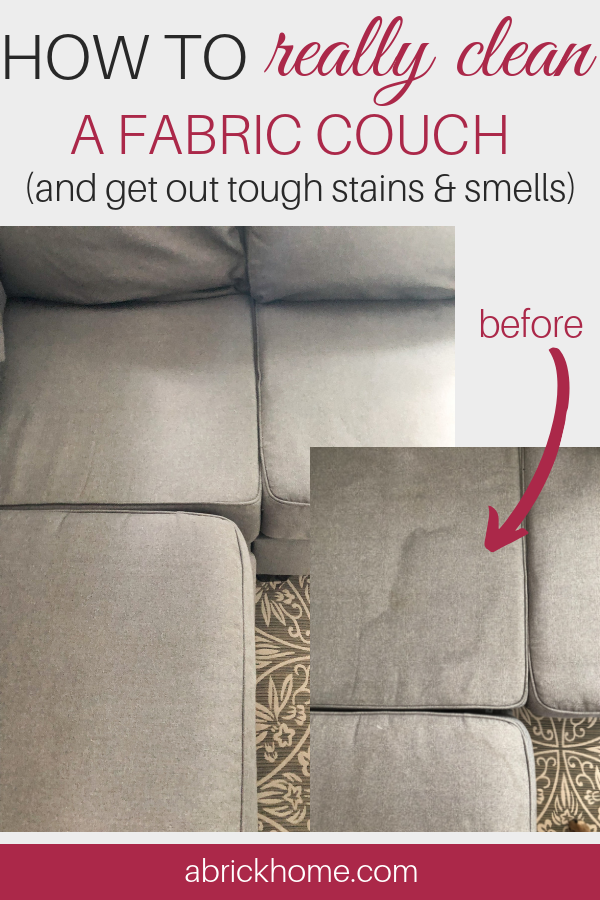Cleaning the couch can sometimes make it look worse due to improper techniques or unsuitable cleaning products. This issue can also arise from dirt surfacing during the cleaning process.
A sparkling clean couch enhances your living space, making it inviting and comfortable. Yet, many face the frustration of their couch looking worse after cleaning. This problem often stems from using incorrect cleaning methods or products. Dirt and stains can resurface, leaving the fabric looking dingy and worn.
Understanding the right cleaning techniques and products for your couch material is crucial. Regular maintenance and prompt attention to spills can prevent deep-seated grime. Always test cleaning solutions on a hidden area first. Consulting professional cleaning services can also ensure your couch remains in top-notch condition.

Credit: marlydice.com
Common Cleaning Mistakes
Cleaning your couch can sometimes make it look worse. This usually happens due to common cleaning mistakes. Understanding these mistakes can help you avoid them. Here, we will discuss two major issues: using the wrong products and over-wetting the fabric.
Using Wrong Products
One common mistake is using the wrong cleaning products. Different fabrics need different cleaners. Using the wrong product can damage the fabric. It can cause stains, discoloration, or even tears.
Always check the label on your couch. It usually tells you what type of cleaner to use. If you are unsure, do a small test patch first. This helps you see if the cleaner will damage the fabric.
Over-wetting The Fabric
Over-wetting the fabric is another common mistake. Using too much water can cause big problems. It can lead to mold and mildew. It can also make the fabric shrink or fade.
To avoid this, use a small amount of water. Blot the fabric instead of soaking it. Use fans or open windows to help the couch dry quickly.
| Common Cleaning Mistake | Possible Consequences | Solution |
|---|---|---|
| Using Wrong Products | Stains, Discoloration, Tears | Check Fabric Label, Test Patch |
| Over-Wetting the Fabric | Mold, Mildew, Shrinking, Fading | Use Less Water, Blot, Dry Quickly |
Impact Of Diy Cleaning
DIY cleaning methods often seem like a good idea at first. Yet, many people find their couch looks worse after cleaning. Understanding the impact of DIY cleaning can prevent common mistakes. Below, we explore the main reasons for these issues.
Improper Techniques
Many DIY cleaning methods use improper techniques. Scrubbing too hard can damage the fabric. Using the wrong cleaning solution can cause discoloration. Here are some common mistakes:
- Over-wetting: Too much water can lead to mold growth.
- Harsh chemicals: Some chemicals can ruin fabric fibers.
- Rubbing stains: Rubbing can push stains deeper into the fabric.
To avoid these mistakes, always test a small area first. Follow the manufacturer’s guidelines for cleaning.
Lack Of Proper Tools
DIY cleaning often lacks the proper tools. Professional cleaners use specialized equipment. These tools ensure a deep clean without damage. Below is a comparison:
| DIY Cleaning Tools | Professional Cleaning Tools |
|---|---|
| Sponges and cloths | Steam cleaners |
| Household vacuums | Industrial vacuums |
| Home cleaning solutions | Specialized cleaning agents |
Proper tools make a significant difference. They can remove deep-seated dirt and stains effectively. Investing in or renting proper tools may be a better option.
Role Of Fabric Type
Understanding the fabric type of your couch is crucial for effective cleaning. Different fabrics react differently to cleaning methods. Some may look worse after cleaning. Let’s explore the reasons behind this.
Sensitive Materials
Some fabrics are very sensitive. They need special care during cleaning. For instance, velvet and silk can be delicate.
- Velvet: Velvet easily gets damaged by water. It needs dry cleaning.
- Silk: Silk is prone to water stains. It also needs special cleaners.
Color Fading Issues
Color fading is a common issue. Fabrics like cotton and linen may fade. This happens especially with harsh cleaners.
| Fabric Type | Risk of Fading |
|---|---|
| Cotton | High |
| Linen | Medium |
Use mild cleaners for these fabrics. Always test a small area first.
Stain Removal Challenges
Cleaning your couch can sometimes lead to unexpected results. Stain removal challenges often make the couch look worse after cleaning. Understanding why this happens is crucial to avoid it in the future.
Deep-set Stains
Deep-set stains are tough to remove. These stains penetrate the fabric, making them stubborn. Even after a thorough cleaning, remnants may remain. This often leads to a patchy look on your couch.
Common deep-set stains include:
- Wine spills
- Coffee stains
- Ink marks
Using the wrong cleaning method can make these stains worse. Sometimes, scrubbing hard spreads the stain further into the fabric. This can leave the couch looking more stained than before.
Spreading Stains
Spreading stains can be another major issue. When you try to clean a stain, the cleaning solution can cause it to spread. This creates a larger stain area, making the couch look worse.
Common causes of spreading stains include:
- Using too much water
- Incorrect cleaning products
- Rubbing instead of blotting
To avoid spreading stains, always blot gently. Use the right cleaning products for your couch fabric. Test a small area first to check the reaction.
| Stain Type | Best Cleaning Method |
|---|---|
| Wine | Blot with cold water, then use a vinegar solution |
| Coffee | Blot with paper towels, then use a mild detergent |
| Ink | Dab with rubbing alcohol, then rinse with water |
Understanding stain removal challenges can help you maintain your couch. It is key to achieving a clean and fresh look.
Professional Cleaning Errors
Professional cleaning should make your couch look fresh and new. But sometimes, errors can result in your couch looking worse. These errors often stem from inexperienced cleaners and inappropriate methods.
Inexperienced Cleaners
Hiring inexperienced cleaners can backfire. They might lack the skills to clean your couch properly. An inexperienced cleaner may use the wrong cleaning solutions. This can lead to fabric damage or discoloration.
Inexperienced cleaners might not test cleaning products first. A small test patch is crucial. Without it, the entire couch could end up stained or faded.
Experience matters. Always choose cleaners with a proven track record. Check for reviews and certifications. Ensure your couch is in safe hands.
Inappropriate Methods
Using inappropriate methods can harm your couch. One common mistake is over-wetting the fabric. Excessive water can seep deep into the couch. This can cause mold and mildew growth.
Some cleaners use harsh chemicals. These can weaken the fabric fibers. Over time, this leads to tears and fraying. It’s essential to use gentle, fabric-safe solutions.
Another inappropriate method is scrubbing too hard. Vigorous scrubbing can damage delicate materials. Instead, use gentle blotting techniques to remove stains.
Below is a table summarizing professional cleaning errors:
| Error | Description |
|---|---|
| Inexperienced Cleaners | Lack of skills and wrong solutions |
| Over-wetting | Causes mold and mildew |
| Harsh Chemicals | Weakens fabric fibers |
| Hard Scrubbing | Damages delicate materials |
To avoid these errors, always research and choose professional cleaners wisely. Your couch deserves the best care possible.
Drying Problems
Cleaning your couch can sometimes lead to unexpected problems. One common issue is the couch looking worse after cleaning. A major culprit behind this is drying problems. Proper drying is crucial to avoid damage and ensure your couch looks its best. Let’s explore the drying problems in detail.
Incomplete Drying
One major drying problem is incomplete drying. This happens when the couch doesn’t dry fully. A damp couch can lead to several issues:
- Lingering moisture can attract dirt and dust.
- The fabric might develop water stains.
- Unpleasant odors can form.
To avoid incomplete drying, ensure proper air circulation. Use fans or dehumidifiers. Check for damp spots and dry them completely.
Mold And Mildew
Another drying problem is the growth of mold and mildew. These thrive in damp environments. Mold and mildew can cause:
- Health problems like allergies and asthma.
- Damage to the fabric and structure.
- Unpleasant, musty smells.
To prevent mold and mildew, ensure your couch is completely dry. Clean any spills immediately. Use mold-resistant sprays for added protection.
| Drying Problems | Effects | Solutions |
|---|---|---|
| Incomplete Drying | Dirt attraction, water stains, odors | Ensure air circulation, use fans |
| Mold and Mildew | Health issues, fabric damage, smells | Immediate spill cleaning, mold-resistant sprays |
Addressing these drying problems can keep your couch in top condition. Proper drying ensures a cleaner, healthier, and more attractive couch.
Fixing Post-cleaning Issues
Cleaning your couch should make it look better. Sometimes, it looks worse. Don’t worry. There are ways to fix it.
Here are some tips to help you get your couch looking great again.
Recleaning Tips
Sometimes, your couch needs another clean. Here are some recleaning tips:
- Use a gentle cleaner suitable for your couch fabric.
- Test the cleaner on a small, hidden area first.
- Use a soft brush to scrub away stains.
- Blot, do not rub, to avoid damage.
- Allow the couch to air dry completely.
When To Seek Professional Help
Sometimes, your efforts are not enough. Here’s when to seek professional help:
- If stains remain after recleaning.
- If the fabric looks damaged or discolored.
- If the couch has a bad smell that won’t go away.
- If the couch is expensive or antique.
- If you are unsure of the cleaning process.
| Issue | Solution |
|---|---|
| Stubborn Stains | Use specialized stain removers or call a professional. |
| Discoloration | Seek professional cleaning to avoid further damage. |
| Bad Odor | Use fabric fresheners or professional deodorizing services. |
| Damaged Fabric | Consult a professional upholstery cleaner. |

Credit: pro.truckmountforums.com
Preventative Measures
Keeping your couch looking fresh and clean can be a challenge. Sometimes, cleaning can make it look worse. To avoid this, taking preventative measures is key. Here are some tips to help you maintain a beautiful couch.
Regular Maintenance
Regular maintenance keeps your couch looking new. Make a habit of vacuuming your couch weekly. This removes dirt and crumbs that can cause stains.
Use a soft brush attachment on your vacuum cleaner. Gently brush the fabric to lift dust and debris. This prevents buildup that can damage the fabric over time.
Spot clean spills immediately. Use a clean cloth and blot the stain. Avoid rubbing as this can spread the stain.
Using Protective Covers
Protective covers are an excellent way to keep your couch looking fresh. They guard against spills, stains, and everyday wear and tear.
| Type of Cover | Benefits |
|---|---|
| Slipcovers | Easy to remove and wash, available in various styles |
| Plastic Covers | Waterproof, protects against spills and stains |
| Fabric Protectors | Breathable, available in different materials |
Choose a cover that suits your lifestyle and decor. Wash the cover regularly to keep it clean. This helps maintain the appearance of your couch underneath.
For added protection, use fabric sprays that repel liquids. These sprays create a barrier that makes cleaning easier.
By following these preventative measures, you can keep your couch looking its best. Regular maintenance and using protective covers will help you avoid common cleaning pitfalls.

Credit: www.reddit.com
Frequently Asked Questions
Why Does My Couch Look Dirtier After Cleaning It?
Residual cleaning solution or improper drying can attract dirt, making your couch look dirtier. Use minimal water and dry thoroughly.
Why Is My Couch Hard After Cleaning?
Your couch may feel hard after cleaning due to residual moisture or detergent. Ensure thorough drying and proper rinsing.
How Long Does It Take A Couch To Dry After Upholstery Cleaning?
A couch typically takes 6 to 12 hours to dry after upholstery cleaning. Drying time varies based on fabric type and humidity.
How Do You Clean A Couch Without Ruining It?
Vacuum the couch to remove loose dirt. Use a mild soap and water solution to spot clean stains. Test any cleaner on a hidden area first. Blot, don’t rub, to avoid damage. Allow the couch to air dry completely.
Why Does My Couch Look Worse After Cleaning?
Improper cleaning methods or harsh chemicals can damage fabric, making your couch appear worse.
Conclusion
A dirty-looking couch after cleaning can be frustrating. Ensure you use proper techniques and quality products for best results. Regular maintenance and timely professional cleaning can keep your couch looking fresh. With these tips, you can enjoy a cleaner, more appealing couch in your living space.





